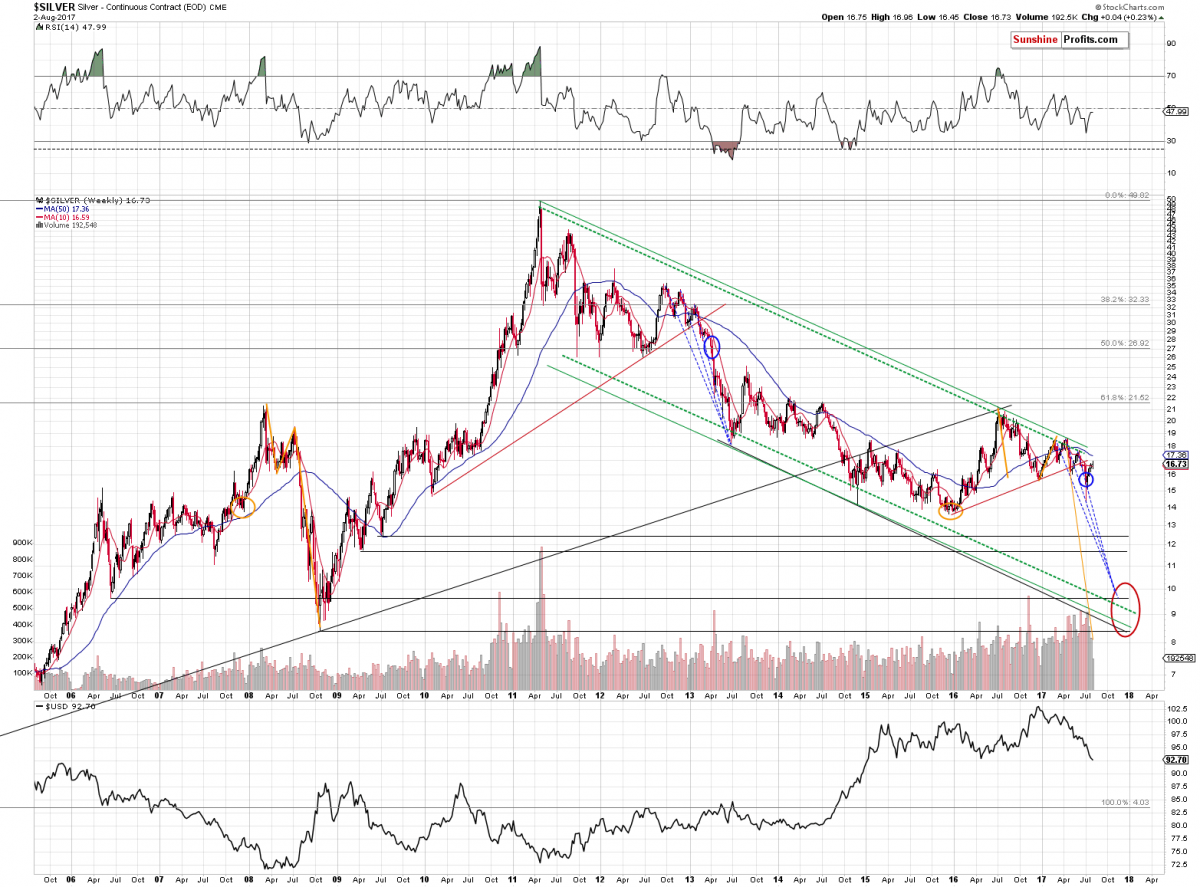Silver Analogies…Invalidated?
Some time ago we discussed the analogies in the silver market…and the implication of the analogies was that a big decline should follow. However, we have not seen anything epic on a medium-term basis – only a local (yet powerful) intra-day slide. Was the analogy invalidated and did the outlook become bullish?
Let’s take a closer look at the silver chart (charts courtesy of http://stockcharts.com) and begin today’s analysis by reminding ourselves of the analogies that we are going to discuss in greater detail.
Quoting the July 10, 2017 Gold & Silver Trading Alert:
The above chart is very rich in important data and analogies and it will take us some time to discuss all of them. Let’s start with the one that was already present before Friday’s session - and then we’ll move to the one that became apparent based on what happened based on it.
The first thing is that silver’s recent, and not so recent (mid-2016 – today) performance is to a large extent a repeat of what we saw in 2008. This time, the price moves took more time, but the price levels themselves are almost identical. The 2008 and 2016 tops both formed a bit above $21 and both were followed by a decline to about $16 (marked with orange lines), which was in turn followed by a rally to about $19 (again, in both cases). Since a huge plunge followed in 2008 – why shouldn’t it follow this time if the previous price swings are so similar in terms of price? The decline in 2008 took silver below $9, so based on this analogy alone, it appears that silver is once again likely to test these levels. Moreover, both rallies (the ones that ended in 2008 and 2016) started from about $14, which further strengthens the analogy between these situations.
Let’s move to the second analogy – the one that seems even more important.
The three local tops in silver that we saw this year are similar to the ones that we saw in 2012 and 2013, right before the big plunge in the price of white metal. This can be seen on a stand-alone basis, but it’s even clearer when we realize that both three-top patterns were preceded by proportionately similar action.
The late-2015 and 2010 bottoms were the ones that preceded the big upswings in silver. In both cases, the initial rally was shortly followed by a consolidation (mid-2010 and Q1 2016), then a sharp rally with a quick correction in the middle (late 2010-early 2011 and Q2 2016)…followed by a top that formed after a very sharp upswing. Both tops were followed by a zig-zag correction and local bottoms (mid-2011, end of Q3 2011, end of 2011, mid-2012, Q3 and Q4 2016). After these bottoms (the final ones took place in mid-2012 and at the end of 2016), we saw rallies that took silver much higher, which ended below the most recent local top (the Q3 2012 rally ended below the Q1 2012 top and the Q1 2017 rally ended below the Q4 2016 top).
Both preceding actions were not identical, but quite similar. This makes the three-top similarity much more profound than if we saw it on a stand-alone basis. But wait, there’s more. The rising support/resistance lines that we can draw (red lines) based on the initial bottom and the interim one also show similarity – both final local bottoms took silver right to this line and the corrective upswing that followed was the final one (Q1 2013 and the May-June 2017 rallies) before the big dive.
With similar preceding action, similar follow-up action is to be expected. We marked the follow-up declines of the 2012 and 2013 tops with blue, dashed lines. Applying these lines to the recent three tops in silver provides us with a coherent price and time target. The fact that they all point to a similar price-time combination further confirms the analogy between the tops. The target based on the three tops and the analogy to the previous ones is about $9.60, which is also the 2006 bottom. So, based on the above analogy, $9.60 is the downside target…and the blue ellipses mark the current moment and the moment in the past that is analogous to it. It seems that the most volatile part of the decline is just ahead.
With two analogies pointing to different price targets (and important long-term declining support lines and levels being between them), what will the final target be? It will depend on what happens in the precious metals market (not only in silver) once we get closer to these levels. If miners show significant strength and gold reaches an important support level, we may not wait for silver to decline to the lowest of targets before moving back into the precious metals market with the long-term investments.
For now, it seems that the final bottom in silver form between $8 and $10.
The question for today is whether anything from the above was invalidated based on silver’s lack of decline and did the above silver price prediction change? In short, the direct price analogy was invalidated, however, the general analogy and the implications still remain intact. Why?
Because of what happened in with the US dollar in the recent months.
The silver market has its own fundamentals - and it’s much more to silver than just the USD Index. However, in the past decade all big moves in silver prices were seen at least in some unison with the value of the US dollar.
The 2005 – 2006 upswing was seen with a horizontal trend in the USD when the final spike took place during the USD’s slide. Silver declined only after the USD Index stopped declining.
The 2007 – 2008 rally in silver was seen with a decline in the USD Index - and the decline started when the USD stopped declining. The huge slide started when USD Index rallied back up.
The 2010 – 2011 rally in silver was also seen with a decline in the USD Index - and the decline started when the USD stopped declining. The huge slide started when USD Index rallied back up in the second half of the year.
The 2012 decline took place when the USD Index did nothing initially and then moved higher.
The huge 2012 – 2013 decline in silver started when the USD Index did nothing initially and then it accelerated dramatically after USD moved higher.
There are many other less visible examples of this relationship. Consequently, for the purpose of this essay, they all have one key implication:
There were no powerful slides in silver if the USD Index was declining.
Why would that be the case?
As the USD declines in value, silver priced in it becomes cheaper for investors and users from abroad and this triggers purchases. Theoretically, it shouldn’t matter that much because the price of silver can move up or down in all currencies, but in practice, it does. When investors are in this “buy mode” the sharp declines are quickly absorbed by this buying power.
Given the declining USD Index, there were only two types of reaction in silver: either moving back and forth or a rally. What we’ve been seeing in the recent weeks and months is a strong suggestion that the silver market does not want to move higher right now and it’s waiting for an opportunity to slide, just like it did in 2013. The USD Index has been refusing to provide such a signal for months now.
On a daily basis, silver may seem to respond to the action in the USD Index, but from the bigger point of view, the link is much more bearish – the USD Index is about 10 index points lower than it was at the beginning of this year and silver is more or less at the same price level (more or less the same is the case with silver stocks). If silver was able to ignore such a huge slide in the USD, then it’s very likely to respond to the USD’s rebound. In fact, it seems that even a stop in the USD’s decline would be enough to trigger a decline in silver.
Moving back to the question in the title of today’s analysis – was the bearish analogy in silver invalidated? No, silver visibly “wants to” decline, just as it’s likely to be based on the analogies that we described previously, however, it is not able to do so given the continuously declining USD Index. The USD Index just reached very important support levels, so the end of the decline could be near. This means that silver could be very close to unfolding the bearish potential that it’s been holding for many weeks.
Summing up, the situation in silver continues to be bearish even though it doesn’t appear to be the case at first sight. Subsequently, the key reason for it seems to be silver’s link to the USD Index and the recent performance of the latter. Once the USD stops declining, silver’s bearish potential is likely to become more and more visible. Should the USD reverse in a volatile manner, silver could truly plunge.
If you enjoyed the above analysis and would like to receive free follow-ups, we encourage you to sign up for our gold newsletter – it’s free and if you don’t like it, you can unsubscribe with just 2 clicks. If you sign up today, you’ll also get 7 days of free access to our premium daily Gold & Silver Trading Alerts. Sign up now.
Przemyslaw Radomski, CFA
Founder, Editor-in-chief, Gold & Silver Fund Manager
Sunshine Profits - Tools for Effective Gold & Silver Investments
* * * * *
All essays, research and information found above represent analyses and opinions of Przemyslaw Radomski, CFA and Sunshine Profits' associates only. As such, it may prove wrong and be a subject to change without notice. Opinions and analyses were based on data available to authors of respective essays at the time of writing. Although the information provided above is based on careful research and sources that are believed to be accurate, Przemyslaw Radomski, CFA and his associates do not guarantee the accuracy or thoroughness of the data or information reported. The opinions published above are neither an offer nor a recommendation to purchase or sell any securities. Mr. Radomski is not a Registered Securities Advisor. By reading Przemyslaw Radomski's, CFA reports you fully agree that he will not be held responsible or liable for any decisions you make regarding any information provided in these reports. Investing, trading and speculation in any financial markets may involve high risk of loss. Przemyslaw Radomski, CFA, Sunshine Profits' employees and affiliates as well as members of their families may have a short or long position in any securities, including those mentioned in any of the reports or essays, and may make additional purchases and/or sales of those securities without notice.


















